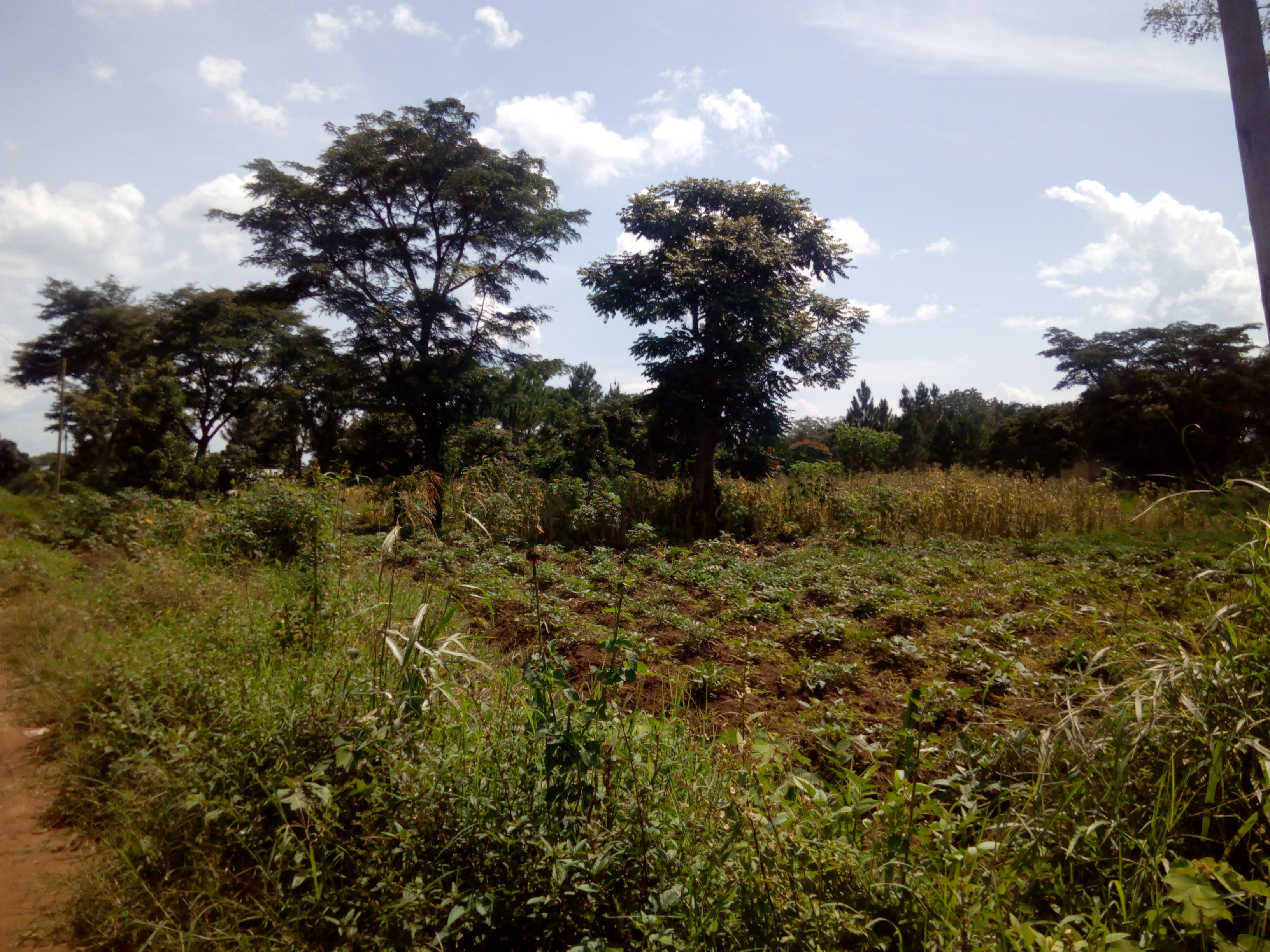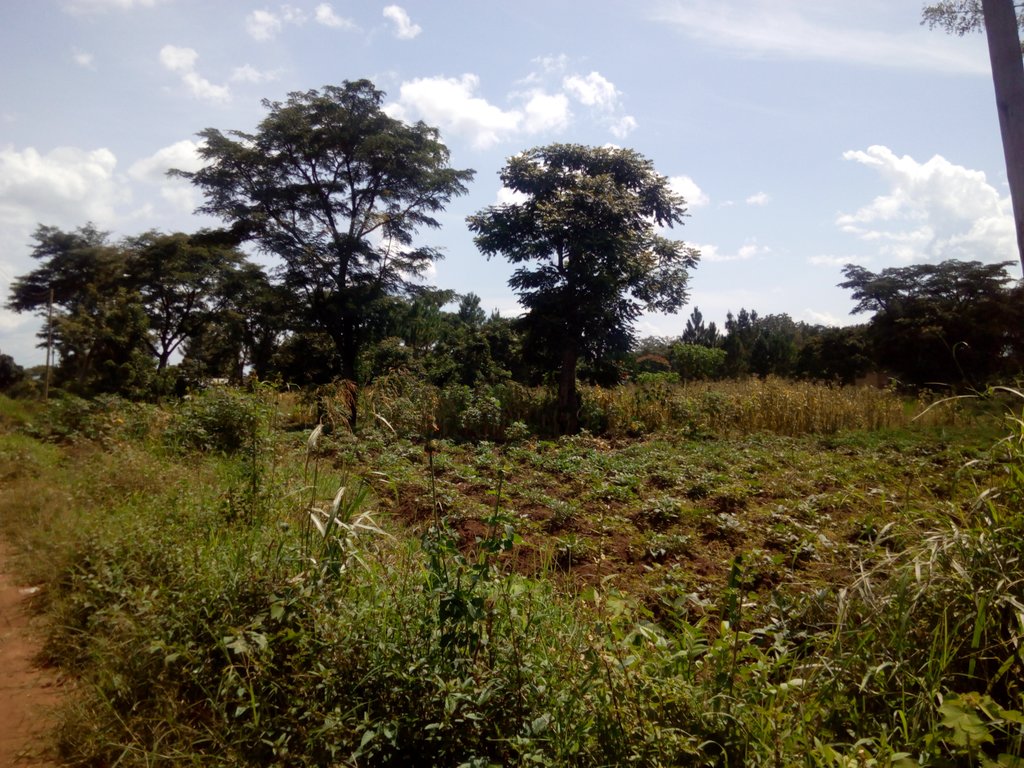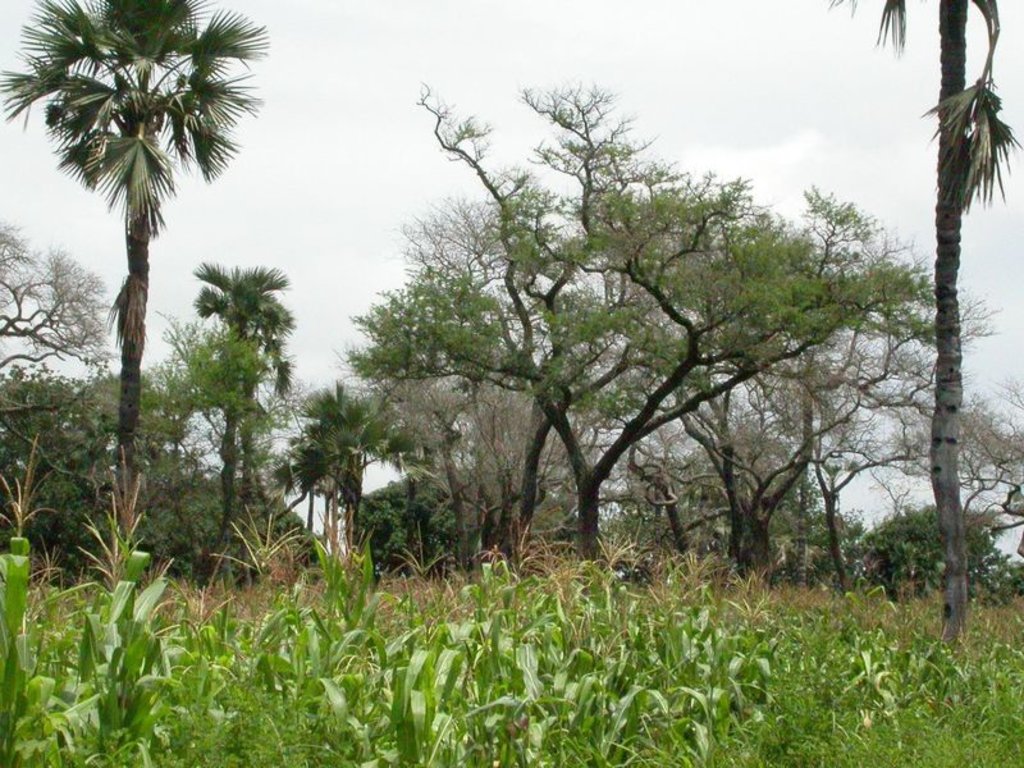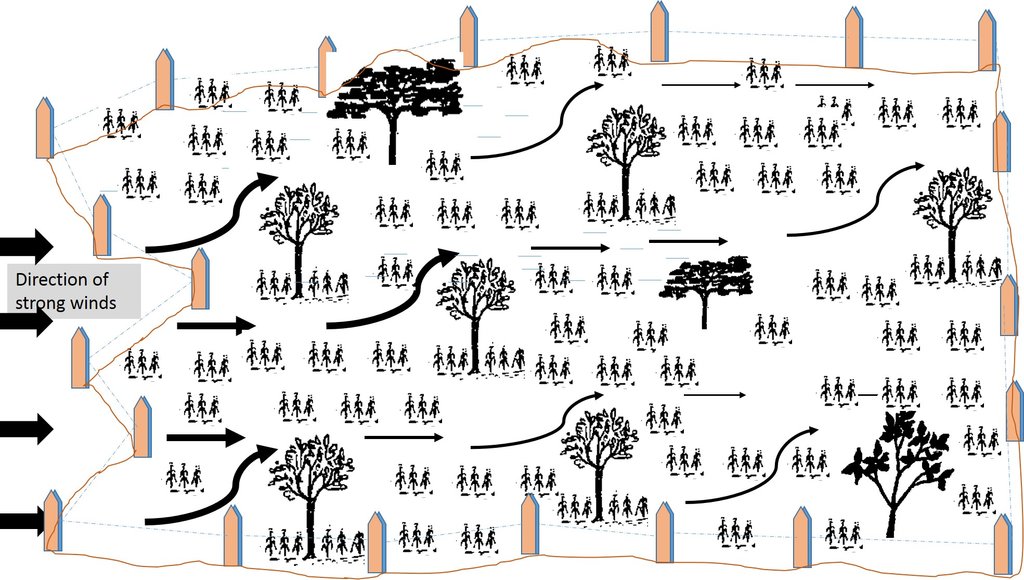Native trees as wind breaks [Uganda]
- Creation:
- Update:
- Compiler: Bernard Fungo
- Editors: JOY TUKAHIRWA, Kamugisha Rick Nelson, betty adoch, Sunday Balla Amale
- Reviewers: Nicole Harari, Renate Fleiner
Gwokoyen Ma tye ki Kony
technologies_2871 - Uganda
View sections
Expand all Collapse all1. General information
1.2 Contact details of resource persons and institutions involved in the assessment and documentation of the Technology
Key resource person(s)
land user:
Otim Richard
+256783771012
Toke Village
Toke Village, Golo Parish, Latanya sub county Pader district
Uganda
Name of project which facilitated the documentation/ evaluation of the Technology (if relevant)
Scaling-up SLM practices by smallholder farmers (IFAD)Name of the institution(s) which facilitated the documentation/ evaluation of the Technology (if relevant)
Uganda Landcare Network (ULN) - Uganda1.3 Conditions regarding the use of data documented through WOCAT
When were the data compiled (in the field)?
9/5/2017
The compiler and key resource person(s) accept the conditions regarding the use of data documented through WOCAT:
Ja
1.4 Declaration on sustainability of the described Technology
Is the Technology described here problematic with regard to land degradation, so that it cannot be declared a sustainable land management technology?
Nee
2. Description of the SLM Technology
2.1 Short description of the Technology
Definition of the Technology:
Native tree scattered in the garden reduce wind speeds and lower chances of winds damaging crops
2.2 Detailed description of the Technology
Description:
In relatively flat areas such as those in semi-arid parts of northern Uganda, strong winds can exacerbate damage to crops and animal structures in addition to increasing evaporation from watering troughs for animals. To reduce the risk of these occurrences, farmers maintain trees interspersed in the croplands or paddocks to intercept the strong winds.
Trees used for this purpose are generally native species because they grow large in diameter (> 60 cm dbh) and develop wide crowns (~20 m diameter). Some of the native tree species for this technology include Shea tree (Vitellaria paradoxa), and Tido (Khaya grandifoliola). The trees are not arranged in any specific pattern since they establish naturally, and are managed to grow and pruned appropriately to better reduce the impact of strong winds. The spacing between trees can range from 10 to 30 meters depending on the size but also on the location of target structures such as homestead and animal structures. By periodically pruning these trees, farmers also get wood for fuel while reducing the risk of injury from branches falling down as they deteriorate with age. The trees also provide shade in homesteads and in grazing lands. Pruning allows younger branches to emerge and ensures the health and longevity of the trees for several decades.
What farmers like about the technology is that the cost of establishment is generally very low as the care and pruning of trees does not require the purchase of any expensive equipment, planting materials are not required, and there is no labour required for planting. The technology does not take so much land since the trees are sparsely scattered in the crop or grazing land or along the boundaries. Also, the trees provide firewood when the branches are pruned. Sometimes farmers locate bee hives in these trees, thereby ensuring income diversification for the household.
Farmers dislike this technology because native tree species take long (15-20 years) to grow to appropriate sizes to effectively reduce the impact of strong winds and they are also in high demand for charcoal production. Furthermore, they can only be retained where they naturally grow, thus not being very effective as wind breaks as would be the case for those trees that are planted in preferred locations in the landscape. It is labour-intensive to prune these generally large trees with complex crowns, especially when they are fully grown. The trees also acts as hosts for birds, which are formidable pests to crops such as sorghum, simsim and maize in the gardens. The roots of trees extend to large areas within the gardens and can potentially reduce the yield of the nearby crops if root-pruning is not done. These trees also provide additional benefits such as shea from Vitellaria paradoxa that are useful as nutritional supplements. Timber from Khaya grandifoliola is highly valuable and earns additional income to the household.
2.3 Photos of the Technology
2.4 Videos of the Technology
Comments, short description:
Video on protected valuable natural tree species in Pader District
Date:
9/5/2017
Location:
Pader District
Name of videographer:
Issa Aliga
2.5 Country/ region/ locations where the Technology has been applied and which are covered by this assessment
Country:
Uganda
Region/ State/ Province:
Northern
Further specification of location:
Latanya s/county Pader District
Map
×2.6 Date of implementation
Indicate year of implementation:
1950
If precise year is not known, indicate approximate date:
- more than 50 years ago (traditional)
2.7 Introduction of the Technology
Specify how the Technology was introduced:
- as part of a traditional system (> 50 years)
3. Classification of the SLM Technology
3.1 Main purpose(s) of the Technology
- reduce, prevent, restore land degradation
- conserve ecosystem
- protect a watershed/ downstream areas – in combination with other Technologies
- preserve/ improve biodiversity
- reduce risk of disasters
- adapt to climate change/ extremes and its impacts
- mitigate climate change and its impacts
3.2 Current land use type(s) where the Technology is applied

Mixed (crops/ grazing/ trees), incl. agroforestry
- Agroforestry
Main products/ services:
Maize, Simsim, Sorghum, Sweet potatoes
If land use has changed due to the implementation of the Technology, indicate land use before implementation of the Technology:
No change
3.3 Further information about land use
Water supply for the land on which the Technology is applied:
- rainfed
Number of growing seasons per year:
- 2
Livestock density (if relevant):
Grazing is done during the dry season usually immediately after harvesting maize and sorghum
3.4 SLM group to which the Technology belongs
- agroforestry
- windbreak/ shelterbelt
3.5 Spread of the Technology
Specify the spread of the Technology:
- evenly spread over an area
If the Technology is evenly spread over an area, indicate approximate area covered:
- < 0.1 km2 (10 ha)
Comments:
Typical land size is approximately 5 acres
3.6 SLM measures comprising the Technology

vegetative measures
- V1: Tree and shrub cover
3.7 Main types of land degradation addressed by the Technology

other
Comments:
Extreme weather events (winds and direct sunshine on crops)
3.8 Prevention, reduction, or restoration of land degradation
Specify the goal of the Technology with regard to land degradation:
- prevent land degradation
- adapt to land degradation
4. Technical specifications, implementation activities, inputs, and costs
4.1 Technical drawing of the Technology
4.2 Technical specifications/ explanations of technical drawing
Trees randomly scattered within cropland
Spacing of trees ranges from 10 to 30 meters
Size of trees ranges from 10 to > 60 cm diameter and 5 to 30 meters in height
4.3 General information regarding the calculation of inputs and costs
Specify how costs and inputs were calculated:
- per Technology unit
Specify unit:
Land management unit
Specify volume, length, etc. (if relevant):
6 acres
other/ national currency (specify):
Uganda Shilings
Indicate exchange rate from USD to local currency (if relevant): 1 USD =:
3500.0
Indicate average wage cost of hired labour per day:
5000
4.4 Establishment activities
| Activity | Type of measure | Timing | |
|---|---|---|---|
| 1. | Protection | Management | Always |
| 2. | Pruning | Management | Once a year |
4.5 Costs and inputs needed for establishment
| Specify input | Unit | Quantity | Costs per Unit | Total costs per input | % of costs borne by land users | |
|---|---|---|---|---|---|---|
| Labour | Labor | 1 | 40.0 | 2000.0 | 80000.0 | 100.0 |
| Total costs for establishment of the Technology | 80000.0 | |||||
4.6 Maintenance/ recurrent activities
| Activity | Type of measure | Timing/ frequency | |
|---|---|---|---|
| 1. | Pruning | Management | Once a year |
4.7 Costs and inputs needed for maintenance/ recurrent activities (per year)
| Specify input | Unit | Quantity | Costs per Unit | Total costs per input | % of costs borne by land users | |
|---|---|---|---|---|---|---|
| Labour | labor | 1 | 40.0 | 2000.0 | 80000.0 | 100.0 |
| Total costs for maintenance of the Technology | 80000.0 | |||||
Comments:
The technology does no require any inputs apart from labour for pruning. Occasionally farmers may plant one or a few additional trees to reinforce the barriers.
4.8 Most important factors affecting the costs
Describe the most determinate factors affecting the costs:
Pruning height of the trees. Higher and larger trees are more expensive to prune but also provide more firewood to the farmer
5. Natural and human environment
5.1 Climate
Annual rainfall
- < 250 mm
- 251-500 mm
- 501-750 mm
- 751-1,000 mm
- 1,001-1,500 mm
- 1,501-2,000 mm
- 2,001-3,000 mm
- 3,001-4,000 mm
- > 4,000 mm
Indicate the name of the reference meteorological station considered:
Gulu, Uganda
Agro-climatic zone
- sub-humid
5.2 Topography
Slopes on average:
- flat (0-2%)
- gentle (3-5%)
- moderate (6-10%)
- rolling (11-15%)
- hilly (16-30%)
- steep (31-60%)
- very steep (>60%)
Landforms:
- plateau/plains
- ridges
- mountain slopes
- hill slopes
- footslopes
- valley floors
Altitudinal zone:
- 0-100 m a.s.l.
- 101-500 m a.s.l.
- 501-1,000 m a.s.l.
- 1,001-1,500 m a.s.l.
- 1,501-2,000 m a.s.l.
- 2,001-2,500 m a.s.l.
- 2,501-3,000 m a.s.l.
- 3,001-4,000 m a.s.l.
- > 4,000 m a.s.l.
Indicate if the Technology is specifically applied in:
- not relevant
5.3 Soils
Soil depth on average:
- very shallow (0-20 cm)
- shallow (21-50 cm)
- moderately deep (51-80 cm)
- deep (81-120 cm)
- very deep (> 120 cm)
Soil texture (topsoil):
- medium (loamy, silty)
Soil texture (> 20 cm below surface):
- medium (loamy, silty)
Topsoil organic matter:
- medium (1-3%)
5.4 Water availability and quality
Ground water table:
5-50 m
Availability of surface water:
medium
Water quality (untreated):
for agricultural use only (irrigation)
Is water salinity a problem?
Nee
Is flooding of the area occurring?
Nee
5.5 Biodiversity
Species diversity:
- medium
Habitat diversity:
- medium
5.6 Characteristics of land users applying the Technology
Sedentary or nomadic:
- Sedentary
Market orientation of production system:
- mixed (subsistence/ commercial
Off-farm income:
- 10-50% of all income
Relative level of wealth:
- average
Individuals or groups:
- individual/ household
Level of mechanization:
- manual work
Gender:
- men
Age of land users:
- youth
5.7 Average area of land owned or leased by land users applying the Technology
- < 0.5 ha
- 0.5-1 ha
- 1-2 ha
- 2-5 ha
- 5-15 ha
- 15-50 ha
- 50-100 ha
- 100-500 ha
- 500-1,000 ha
- 1,000-10,000 ha
- > 10,000 ha
Is this considered small-, medium- or large-scale (referring to local context)?
- medium-scale
5.8 Land ownership, land use rights, and water use rights
Land ownership:
- individual, not titled
Land use rights:
- individual
Water use rights:
- individual
5.9 Access to services and infrastructure
health:
- poor
- moderate
- good
education:
- poor
- moderate
- good
technical assistance:
- poor
- moderate
- good
employment (e.g. off-farm):
- poor
- moderate
- good
markets:
- poor
- moderate
- good
energy:
- poor
- moderate
- good
roads and transport:
- poor
- moderate
- good
drinking water and sanitation:
- poor
- moderate
- good
financial services:
- poor
- moderate
- good
6. Impacts and concluding statements
6.1 On-site impacts the Technology has shown
Socio-economic impacts
Production
wood production
Other socio-economic impacts
Time spent looking for firewood
Ecological impacts
Climate and disaster risk reduction
wind velocity
micro-climate
6.2 Off-site impacts the Technology has shown
wind transported sediments
6.3 Exposure and sensitivity of the Technology to gradual climate change and climate-related extremes/ disasters (as perceived by land users)
Climate-related extremes (disasters)
Climatological disasters
| How does the Technology cope with it? | |
|---|---|
| heatwave | well |
Other climate-related extremes (disasters)
| other (specify) | How does the Technology cope with it? |
|---|---|
| Strong winds | very well |
6.4 Cost-benefit analysis
How do the benefits compare with the establishment costs (from land users’ perspective)?
Short-term returns:
positive
Long-term returns:
very positive
How do the benefits compare with the maintenance/ recurrent costs (from land users' perspective)?
Short-term returns:
positive
Long-term returns:
very positive
6.5 Adoption of the Technology
- 10-50%
Of all those who have adopted the Technology, how many have did so spontaneously, i.e. without receiving any material incentives/ payments?
- 50-90%
6.6 Adaptation
Has the Technology been modified recently to adapt to changing conditions?
Nee
6.7 Strengths/ advantages/ opportunities of the Technology
| Strengths/ advantages/ opportunities in the land user’s view |
|---|
| Also provides fire wood for the household |
| Trees also provide shade for the crops and livestock |
| Strengths/ advantages/ opportunities in the compiler’s or other key resource person’s view |
|---|
| Fire wood can be obtained in addition to the environmental services that the trees provide |
6.8 Weaknesses/ disadvantages/ risks of the Technology and ways of overcoming them
| Weaknesses/ disadvantages/ risks in the land user’s view | How can they be overcome? |
|---|---|
| Attracts wild animals e.g. snakes | |
| Only men are able to implement the technology because it is difficult |
| Weaknesses/ disadvantages/ risks in the compiler’s or other key resource person’s view | How can they be overcome? |
|---|---|
| The trees sometimes attract wild animals such as snakes and squirrels. | |
| Protection from wild fire is sometimes required if the trees are close (< 10 meters) |
7. References and links
7.1 Methods/ sources of information
- field visits, field surveys
1
- interviews with land users
1
7.2 References to available publications
Title, author, year, ISBN:
N/a
7.3 Links to relevant information which is available online
Title/ description:
Agroforestry system (intercropping beans/maize) with contour ditches, strips of Napier grass, manure and organic fertilizers. (Kenya)
URL:
https://qcat.wocat.net/en/summary/2755/?as=html
Title/ description:
Dynamic agroforestry systems (Bolivia, Plurinational State of)
URL:
https://qcat.wocat.net/en/summary/514/?as=html
Links and modules
Expand all Collapse allLinks
No links
Modules
No modules






